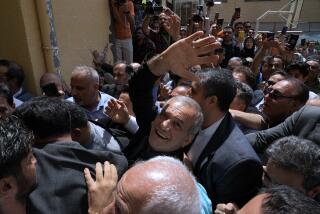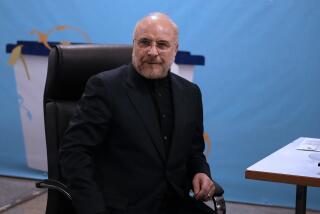Iran’s Hard-Liners Fight Back With Rally, Death Threats
- Share via
WASHINGTON — In an attempt to end spiraling unrest, Iran’s conservative religious leaders Wednesday mobilized tens of thousands of people for a “unity rally” in Tehran. The nation’s top security official warned that “counter-revolutionaries” and “saboteurs” behind six days of student protests face the death sentence.
“We will resolutely and decisively quell any attempt to rebel,” declared Hassan Rouhani, secretary of the Supreme National Security Council and deputy speaker of parliament, in remarks broadcast by Iranian television. “Those who destroyed public property and went on the rampage and committed aggression against the Islamic system will be tried in our courts. . . . Our revolution needs a sweeping cleanup.”
Late Wednesday, Interior Minister Abdul Vahed Musavi-Lari declared that the worst unrest since the 1979 revolution had been contained and order restored.
The two-hour rally, organized by the Islamic Propagation Office, featured senior clerics from Iran’s most conservative bodies: the judiciary, parliament and security branches, all allied with the nation’s supreme leader, Ayatollah Ali Khamenei.
State television provided live coverage of the event, along with patriotic songs and emotional footage of the 1980-88 war against Iraq.
Thousands of demonstrators roared pro-regime slogans and “Death to America,” and many held up large posters of Khamenei. “My life belongs to the leaders,” read several signs.
Notably absent was President Mohammad Khatami, a reformer who won 70% of the vote in a stunning election upset in 1997. At the heart of the recent protests is Khatami’s reform agenda, which has been repeatedly blocked or reversed by conservatives, triggering growing frustration among Iran’s restless youth.
After the rally, the Iranian press reported that student organizers had suspended protests for now but would still press for a response to their 14-point list of demands and for information about missing bodies of students killed during the demonstrations. The government claimed that only one student had died during six days of unrest; an opposition group in exile maintained that there had been 30 deaths.
Although some moderate groups reportedly backed the pro-government rally, leaders of the United Student Front said they would not attend. The organization also has disavowed the rioting that led to property damage and personal injuries Monday and Tuesday as the originally peaceful protests turned violent after vigilante groups tried to disrupt demonstrations.
Wednesday’s rally signaled the onset of what is likely to be the toughest government crackdown against reformers since Khatami’s election.
Hundreds of Iranians who have been arrested during the unrest, which spread to more than a dozen cities, face tough prosecution. Under Islamic law, two of the most serious crimes are mofsed, which means “corrupt on Earth,” and mohareb, which means “those fighting God.” Both are punishable by death. In his broadcast remarks, Rouhani, the top security official, said instigators of the unrest would be tried on charges of mofsed.
And the wave of arrests is not over, according to police officials who said security forces were searching for others linked to the unrest.
Rouhani’s speech also suggested that the defendants may be tried by secret Revolutionary Courts rather than by the regular justice system, a move that could further inflame passions. Among the students’ original demands were open trials, especially for political cases.
The government also put students and their supporters on notice that it will not tolerate further violence. In a statement released by the Islamic Republic News Agency, Ayatollah Khamenei ordered an end to all unauthorized assemblies. Security forces have been “emphatically instructed to put down the corrupt and warring elements,” he said.
The government will no longer tolerate “vicious people, supported by certain bankrupt political groups and encouraged by foreign enemies, [who are] engaged in destruction of people’s property,” his statement warned.
Meanwhile, Defense Minister Ali Shamkhani hinted that the military may be deployed. “We will enforce security at any price,” he said.
The tactics of intimidation may keep the streets quiet and force students to look for more subtle and less contentious forms of expression, experts said. At the same time, the crackdown is likely to reinforce the students’ concerns about the prospects of reform and whether pivotal elections next spring for the parliament, which is now dominated by conservatives, will be free from manipulation.
Ultimately, the danger posed by a no-holds-barred crackdown is even deeper polarization, experts said.
“In the short run, the people who control the guns control the power. But that is a waning asset when 70% of the people or more are against you,” said Geoffrey Kemp, director of an Iran project at the Nixon Center for Peace and Freedom and a National Security Council staffer during the Reagan administration.
“The imposition of a dictatorship, which is what that would imply, can only create a bigger and more organized backlash in the future,” he said. “Furthermore, it will end Iran’s honeymoon with the international community, which will worsen its horrendous economic problems--hurting frustrated youth even more.”
More to Read
Sign up for Essential California
The most important California stories and recommendations in your inbox every morning.
You may occasionally receive promotional content from the Los Angeles Times.













